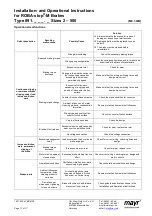
Installation- and Operational Instructions
for ROBA-stop
®
-M Brakes
Type 891. _ _ _ . _ Sizes 2 – 500
(B.8.1.GB)
16/11/2005 TK/KE/RJ
Chr. Mayr GmbH + Co. KG
Tel.: 08341 / 804-0
Eichenstraße 1
Fax: 08341 / 804-421
D-87665 Mauerstetten
http://www.mayr.de
Page 15 of 17
Germany
eMail:
13. Maintenance
ROBA-stop
®
-M brakes are mainly maintenance-free.
Although the rotor (4) is of course subject to functional wear and
tear.
Our rotor (4) is particularly robust and wear-resistant, leading to a
particularly high brake life-time. However, if the rotor (4) does
become worn by a high total friction work, and the function of the
brake can no longer be guaranteed, it is possible to change the
rotor to bring the brake back to its original condition. In this case,
please check the quality of the counter friction surface.
The amount of wear on the rotor (4) can be measured by the
release voltage or, on a dismantled brake, by measuring the rotor
thickness according to Tables 4/5.
The release voltage may be maximum 90% of the nominal voltage
on a warm brake.
The amount of wear on the rotor (4) must be examined during the
regular inspection intervals, which should occur:
At least half-yearly or at least after 1000 operational hours.
The inspection should include:
Inspection of the rotor thickness (wear).
Inspection of the rotor gearing (4) and the hub (1) for smooth
movement, higher backlash and damage.
Max. permitted rotor-torsional backlash on the hub, sizes M2 -
M32
→
0,5°, sizes M60 - M500
→
0,3°.
Inspection on engaged brake and load-free output caused by
motor shaft-torsion.
Inspection of the armature disc (3) and the flange plates (12/13)
or the friction surface of the motor shield for plane-parallelity
and wear (to strong formation of grooves).
Brake-cleansing.
Wear time periods are influenced by many factors and can vary
accordingly. The necessary inspection and maintenance intervals
must be calculated individually according to the system
manufacturer engineering documentation.
Exchanging the rotor (4):
Warning: The brake must be load-free. Check that it
is load-free before de-installing it.
To exchange the rotor (4), the brake must be
unscrewed from the motor bearing shield or from the
machine wall.
13.1. Remove the fixing screws (8).
13.2. Clean the brake (keep an industrial vacuum handy and wear a
mask).
Continue work as described in Points 6.2 and 6.4. Remove
abrasion particles using pressurised air.
13.3. Pull the rotor (4) off the hub (1).
13.4. Check the hub (1) for damage and, if necessary, replace it.
13.5. Inspect the armature disc (3) and the counter friction surface
for signs of wear and plane-parallelity (from sizes 2 – 60:
0,03 mm; from sizes 100 to 500: 0,05 mm). You should not be
able to find deep grooves. If necessary, exchange the
armature disc (3) and the flange plates (12/13).
(Continue work as described in Points 6.2 and 6.4).
13.6. Measure the new rotor thickness (4) and compare it with the
values given in Tables 4/5.
13.7. Push the rotor (4) onto the hub (1) and check for radial
backlash. If there is a larger amount of backlash in the
gearing jaws between the hub (1) and the rotor (4), the hub
(1) must be removed from the shaft and replaced.
13.8. Screw on the brake to the motor bearing shield or the
machine wall using the fixing screws (8) (for tightening torque
see Table 2).
Warning!
In brakes with reduced braking torque and/or operation with fast
acting rectifier, excessive wear over the permitted values will not be
noticeable via the switching behaviour of the brake, as the magnetic
coil (7) is, in this case, capable of allowing a very large tension path
for the armature disc (3). Inordinate wear relaxes the springs,
leading to a torque reduction.
Disposal
The components of our electromagnetic brakes must be disposed of
separately as they consist of separate materials. Please follow the
official regulations. Key numbers can change according to
componentseparation (metal, plastic and cable).
Electronic components
(Rectifier / ROBA
®
-switch / micro switch):
The unseparated products can be disposed of at the waste dump
under Key No. 160214 (Mixed Materials) or Components under Key
No. 160216 or by a certified disposal firm.
Brake bodies consisting of steel girders with coil / cable and all
other steel components:
steel scrap
(Key No. 160117)
All aluminium components:
non-iron components (Key No. 160118)
Brake rotors (steel or aluminium girders with friction lining):
brake linings
(Key No. 160112)
Seals, O-rings, V-seals, elastomere, terminal boxes (PVC):
Plastic
(Key No. 160119)

















